
TsOS / DSP_guide_Smith / Ch25
.pdf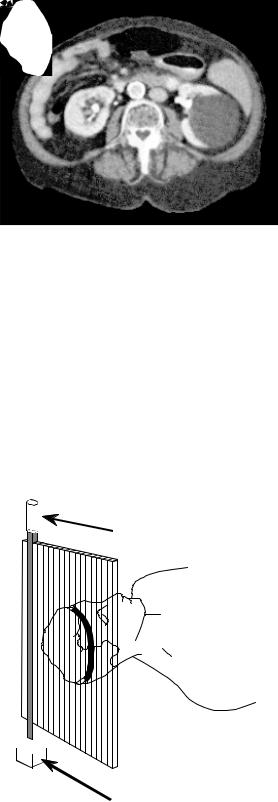
Chapter 25Special Imaging Techniques
FIGURE 25-13
Computed tomography image. This CT slice is of a human abdomen, at the level of the navel. Many organs are visible, such as the (L) Liver,
(K) Kidney, (A) Aorta, (S) Spine, and (C) Cyst covering the right kidney. CT can visualize internal anatomy far better than conventional medical x-rays.
LEFT
FRONT
A
K S
REAR
443
RIGHT
L
C
along the beam's path. Materials such as bone and teeth block more of the x- rays, resulting in a lower signal compared to soft tissue and fat. As shown in the illustration, the source and detector assemblies are translated to acquire a view (CT jargon) at this particular angle. While this figure shows only a single view being acquired, a complete CT scan requires 300 to 1000 views taken at rotational increments of about 0.3E to 1.0E. This is accomplished by mounting the x-ray source and detector on a rotating gantry that surrounds the patient. A key feature of CT data acquisition is that x-rays pass only through the slice of the body being examined. This is unlike classical tomography where x-rays are passing through structures that you try to suppress in the final image. Computed tomography doesn't allow information from irrelevant locations to even enter the acquired data.
radiation detector
FIGURE 25-14
CT data acquisition. A simple CT system passes a narrow beam of x-rays through the body from source to detector. The source and detector are then translated to obtain a complete view. The remaining views are obtained by rotating the source and detector in about 1E increments, and repeating the translation process.
radiation  source
source 
444 |
The Scientist and Engineer's Guide to Digital Signal Processing |
Several preprocessing steps are usually needed before the image reconstruction can take place. For instance, the logarithm must be taken of each x-ray measurement. This is because x-rays decrease in intensity exponentially as they pass through material. Taking the logarithm provides a signal that is linearly related to the characteristics of the material being measured. Other preprocessing steps are used to compensate for the use of polychromatic (more than one energy) x-rays, and multielement detectors (as opposed to the single element shown in Fig. 25-14). While these are a key step in the overall technique, they are not related to the reconstruction algorithms and we won't discuss them further.
Figure 25-15 illustrates the relationship between the measured views and the corresponding image. Each sample acquired in a CT system is equal to the sum of the image values along a ray pointing to that sample. For example, view 1 is found by adding all the pixels in each row. Likewise, view 3 is found by adding all the pixels in each column. The other views, such as view 2, sum the pixels along rays that are at an angle.
There are four main approaches to calculating the slice image given the set of its views. These are called CT reconstruction algorithms. The first method is totally impractical, but provides a better understanding of the problem. It is based on solving many simultaneous linear equations. One equation can be written for each measurement. That is, a particular sample in a particular profile is the sum of a particular group of pixels in the image. To calculate N 2 unknown variables (i.e., the image pixel values), there must be N 2 independent equations, and therefore N 2 measurements. Most CT scanners acquire about 50% more samples than rigidly required by this analysis. For example, to reconstruct a 512×512 image, a system might take 700 views with 600 samples in each view. By making the problem overdetermined in this manner, the final image has reduced noise and artifacts. The problem with this first method of CT reconstruction is computation time. Solving several hundred thousand simultaneous linear equations is an daunting task.
The second method of CT reconstruction uses iterative techniques to calculate the final image in small steps. There are several variations of this method: the Algebraic Reconstruction Technique (ART), Simultaneous Iterative Reconstruction Technique (SIRT), and Iterative Least Squares Technique (ILST). The difference between these methods is how the successive corrections are made: ray-by-ray, pixel-by-pixel, or simultaneously correcting the entire data set, respectively. As an example of these techniques, we will look at ART.
To start the ART algorithm, all the pixels in the image array are set to some arbitrary value. An iterative procedure is then used to gradually change the image array to correspond to the profiles. An iteration cycle consists of looping through each of the measured data points. For each measured value, the following question is asked: how can the pixel values in the a r r a y b e c h a n g e d t o m a k e t h e m c o n s i s t e n t w i t h t h i s p a r t i c u l a r measurement? In other words, the measured sample is compared with the
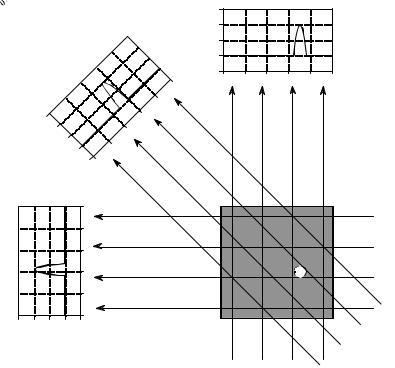
Chapter 25Special Imaging Techniques |
445 |
|
view 1 |
|
|
3 |
|
|
2 |
|
|
1 |
|
view 2 |
0 |
|
-1 |
||
|
view 3
FIGURE 25-15
CT views. Computed tomography acquires a set of views and then reconstructs the corresponding image. Each sample in a view is equal to the sum of the image values along the ray that points to that sample. In this example, the image is a small pillbox surrounded by zeros. While only three views are shown here, a typical CT scan uses hundreds of views at slightly different angles.
sum of the image pixels along the ray pointing to the sample. If the ray sum is lower than the measured sample, all the pixels along the ray are increased in value. Likewise, if the ray sum is higher than the measured sample, all of the pixel values along the ray are decreased. After the first complete iteration cycle, there will still be an error between the ray sums and the measured values. This is because the changes made for any one measurement disrupts all the previous corrections made. The idea is that the errors become smaller with repeated iterations until the image converges to the proper solution.
Iterative techniques are generally slow, but they are useful when better algorithms are not available. In fact, ART was used in the first commercial medical CT scanner released in 1972, the EMI Mark I. We will revisit iterative techniques in the next chapter on neural networks. Development of the third and forth methods have almost entirely replaced iterative techniques in commercial CT products.
The last two reconstruction algorithms are based on formal mathematical solutions to the problem. These are elegant examples of DSP. The third method is called filtered backprojection. It is a modification of an older
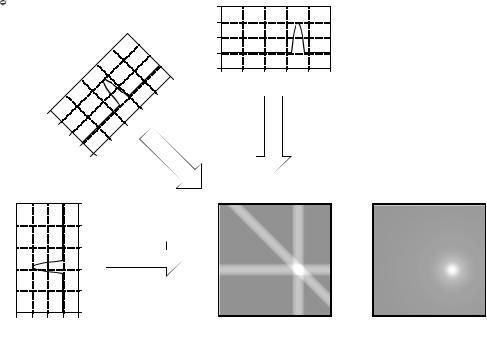
446 |
The Scientist and Engineer's Guide to Digital Signal Processing |
|
view 1 |
|
|
3 |
|
|
2 |
|
|
1 |
|
view 2 |
0 |
|
-1 |
||
|
view 3
a. Using 3 views |
b. Using many views |
FIGURE 25-16
Backprojection. Backprojection reconstructs an image by taking each view and smearing it along the path it was originally acquired. The resulting image is a blurry version of the correct image.
technique, called backprojection or simple backprojection. Figure 25-16 shows that simple backprojection is a common sense approach, but very unsophisticated. An individual sample is backprojected by setting all the image pixels along the ray pointing to the sample to the same value. In less technical terms, a backprojection is formed by smearing each view back through the image in the direction it was originally acquired. The final backprojected image is then taken as the sum of all the backprojected views.
While backprojection is conceptually simple, it does not correctly solve the problem. As shown in (b), a backprojected image is very blurry. A single point in the true image is reconstructed as a circular region that decreases in intensity away from the center. In more formal terms, the point spread function of backprojection is circularly symmetric, and decreases as the reciprocal of its radius.
Filtered backprojection is a technique to correct the blurring encountered in simple backprojection. As illustrated in Fig. 25-17, each view is filtered before the backprojection to counteract the blurring PSF. That is, each of the one-dimensional views is convolved with a one-dimensional filter kernel to create a set of filtered views. These filtered views are then backprojected to provide the reconstructed image, a close approximation to the "correct" image. In fact, the image produced by filtered backprojection is identical
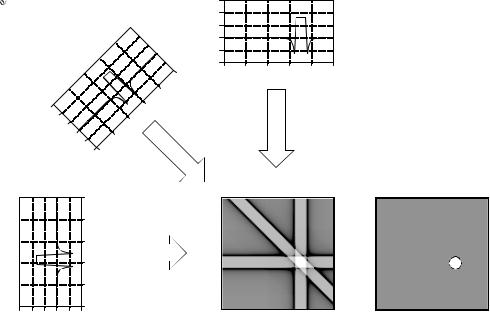
Chapter 25Special Imaging Techniques |
447 |
|
filtered view 1 |
|
3 |
|
2 |
|
1 |
filtered |
0 |
-1 |
|
view 2 |
-2 |
|
filtered view 3
view 3
a. Using 3 views |
b. Using many views |
FIGURE 25-17
Filtered backprojection. Filtered backprojection reconstructs an image by filtering each view before backprojection. This removes the blurring seen in simple backprojection, and results in a mathematically exact reconstruction of the image. Filtered backprojection is the most commonly used algorithm for computed tomography systems.
to the "correct" image when there are an infinite number of views and an infinite number of points per view.
The filter kernel used in this technique will be discussed shortly. For now, notice how the profiles have been changed by the filter. The image in this example is a uniform white circle surrounded by a black background (a pillbox). Each of the acquired views has a flat background with a rounded region representing the white circle. Filtering changes the views in two significant ways. First, the top of the pulse is made flat, resulting in the final backprojection creating a uniform signal level within the circle. Second, negative spikes have been introduced at the sides of the pulse. When backprojected, these negative regions counteract the blur.
The fourth method is called Fourier reconstruction. In the spatial domain, CT reconstruction involves the relationship between a two-dimensional image and its set of one-dimensional views. By taking the two-dimensional Fourier transform of the image and the one-dimensional Fourier transform of each of its views, the problem can be examined in the frequency domain. As it turns out, the relationship between an image and its views is far simpler in the frequency domain than in the spatial domain. The frequency domain analysis
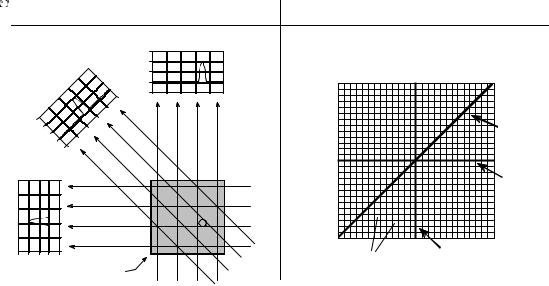
448 |
The Scientist and Engineer's Guide to Digital Signal Processing |
of this problem is a milestone in CT technology called the Fourier slice theorem.
Figure 25-18 shows how the problem looks in both the spatial and the frequency domains. In the spatial domain, each view is found by integrating the image along rays at a particular angle. In the frequency domain, the image spectrum is represented in this illustration by a two-dimensional grid. The spectrum of each view (a one-dimensional signal) is represented by a dark line superimposed on the grid. As shown by the positioning of the lines on the grid, the Fourier slice theorem states that the spectrum of a view is identical to the values along a line (slice) through the image spectrum. For instance, the spectrum of view 1 is the same as the center column of the image spectrum, and the spectrum of view 3 is the same as the center row of the image spectrum. Notice that the spectrum of each view is positioned on the grid at the same angle that the view was originally acquired. All these frequency spectra include the negative frequencies and are displayed with zero frequency at the center.
Fourier reconstruction of a CT image requires three steps. First, the onedimensional FFT is taken of each view. Second, these view spectra are used to calculate the two-dimensional frequency spectrum of the image, as outlined by the Fourier slice theorem. Since the view spectra are arranged radially, and the correct image spectrum is arranged rectangularly, an interpolation routine is needed to make the conversion. Third, the inverse FFT is taken of the image spectrum to obtain the reconstructed image.
|
Spatial Domain |
Frequency Domain |
|||
|
view 1 |
|
|
|
|
|
3 |
|
|
|
|
|
2 |
|
|
|
|
view |
1 |
0 |
Column |
N-1 |
|
0 |
|||||
|
|||||
2 |
-1 |
0 |
|
|
|
|
|
|
|||
|
|
|
|
spectrum |
|
|
|
|
|
of view 2 |
|
|
|
Row |
|
spectrum |
|
|
|
|
|
||
|
|
|
|
of view 3 |
|
view 3 |
|
1 |
|
|
|
|
|
N- |
|
|
|
|
|
spectrum |
spectrum |
|
|
|
image |
of the image |
of view 1 |
|
|
|
|
|
|||
|
|
(the grid) |
|
|
|
FIGURE 25-18
The Fourier Slice Theorem. The Fourier Slice Theorem describes the relationship between an image and its views in the frequency domain. In the spatial domain, each view is found by integrating the image along rays at a particular angle. In the frequency domain, the spectrum of each view is a one-dimensional "slice" of the two-dimensional image spectrum.
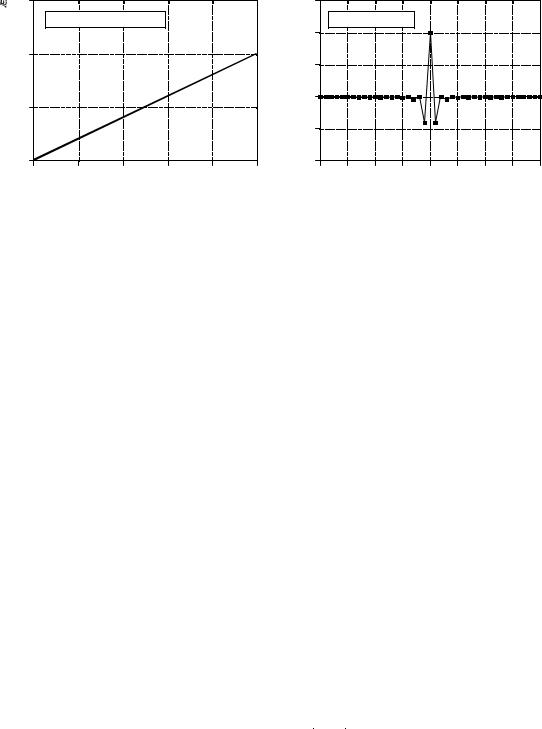
Chapter 25Special Imaging Techniques |
449 |
1.5 |
|
|
|
|
|
|
a. Frequency response |
|
|
|
|
1.0 |
|
|
|
|
|
AmplitudeAmplitude |
|
|
|
|
|
0.5 |
|
|
|
|
|
0.0 |
|
|
|
|
|
0 |
0.1 |
0.2 |
0.3 |
0.4 |
0.5 |
Spatial Frequency
|
1.5 |
|
|
|
|
|
|
|
|
|
|
b. Filter kernel |
|
|
|
|
|
||
|
1.0 |
|
|
|
|
|
|
|
|
AmplitudeAmplitude |
0.5 |
|
|
|
|
|
|
|
|
0.0 |
|
|
|
|
|
|
|
|
|
|
|
|
|
|
|
|
|
|
|
-0.5 |
|
|
|
|
|
|
|
|
|
-1.0 |
|
|
|
|
|
|
|
|
|
|
-20 |
-15 |
-10 |
-5 |
0 |
5 |
10 |
15 |
20 |
Sample number
FIGURE 25-19
Backprojection filter. The frequency response of the corresponding filter kernel is shown in (b). Equation
backprojection filter is shown in (a), and the 25-2 provides the values for the filter kernel.
This "radial to rectangular" conversion is also the key for understanding filtered backprojection. The radial arrangement is the spectrum of the backprojected image, while the rectangular grid is the spectrum of the correct image. If we compare one small region of the radial spectrum with the corresponding region of the rectangular grid, we find that the sample values are identical. However, they have a different sample density. The correct spectrum has uniformly spaced points throughout, as shown by the even spacing of the rectangular grid. In comparison, the backprojected spectrum has a higher sample density near the center because of its radial arrangement. In other words, the spokes of a wheel are closer together near the hub. This issue does not affect Fourier reconstruction because the interpolation is from the values of the nearest neighbors, not their density.
The filter in filtered backprojection cancels this unequal sample density. In particular, the frequency response of the filter must be the inverse of the sample density. Since the backprojected spectrum has a density of 1/f, the appropriate filter has a frequency response of H [f ] ' f . This frequency response is shown in Fig. 25-19a. The filter kernel is then found by taking the inverse Fourier transform, as shown in (b). Mathematically, the filter kernel is given by:
EQUATION 25-2
The filter kernel for filtered backprojection. Figure 25-19b shows a graph of this kernel.
h [0] ' 1
h [k ] |
' 0 |
for even values of k |
|
h [k ] |
' |
4 /B2 |
for odd values of k |
|
|||
k 2
450 |
The Scientist and Engineer's Guide to Digital Signal Processing |
Before leaving the topic of computed tomography, it should be mentioned that there are several similar imaging techniques in the medical field. All use extensive amounts of DSP. Positron emission tomography (PET) involves injecting the patient with a mildly radioactive compound that emits positrons. Immediately after emission, the positron annihilates with an electron, creating two gamma rays that exit the body in exactly opposite directions. Radiation detectors placed around the patient look for these back-to-back gamma rays, identifying the location of the line that the gamma rays traveled along. Since the point where the gamma rays were created must be somewhere along this line, a reconstruction algorithm similar to computed tomography can be used. This results in an image that looks similar to CT, except that brightness is related to the amount of the radioactive material present at each location. A unique advantage of PET is that the radioactive compounds can be attached to various substances used by the body in some manner, such as glucose. The reconstructed image is then related to the concentration of this biological substance. This allows the imaging of the body's physiology rather than simple anatomy. For example, images can be produced showing which portions of the human brain are involved in various mental tasks.
A more direct competitor to computed tomography is magnetic resonance imaging (MRI), which is now found in most major hospitals. This technique was originally developed under the name nuclear magnetic resonance (NMR). The name change was for public relations when local governments protested the use of anything nuclear in their communities. It was often an impossible task to educate the public that the term nuclear simply referred to the fact that all atoms contain a nucleus. An MRI scan is conducted by placing the patient in the center of a powerful magnet. Radio waves in conjunction with the magnetic field cause selected nuclei in the body to resonate, resulting in the emission of secondary radio waves. These secondary radio waves are digitized and form the data set used in the MRI reconstruction algorithms. The result is a set of images that appear very similar to computed tomography. The advantages of MRI are numerous: good soft tissue discrimination, flexible slice selection, and not using potentially dangerous x-ray radiation. On the negative side, MRI is a more expensive technique than CT, and poor for imaging bones and other hard tissues. CT and MRI will be the mainstays of medical imaging for many years to come.
